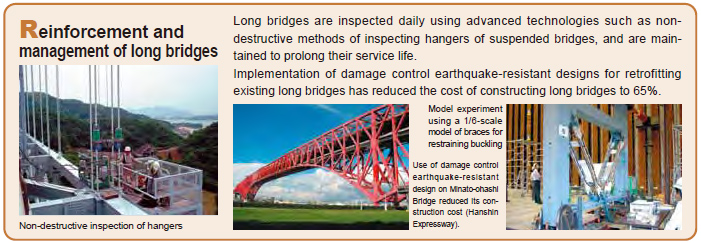Technology
1. Measures for roads utilizing science and technology
In accordance with the 5th Science and Technology Basic Plan, we will fully utilize technology innovations including IoT, big data, AI, and robotics, and promote next-generation road technologies such as advanced anti-deterioration measures for road stock and smoothing of road traffic flow.
Background / Data
-In recent years, technical innovations including IoT, big data, AI and robotics, have made rapid progress.
- Solutions to challenges around roads and traffic that fully utilize ICT are expected.
Measures related to roads regarding next-generation road technology
○Policies related to road maintenance and administration
-To extend lifespan and improve efficiency by introducing new technologies.
- Drive control and operational assistance for more sophisticated snowplows.
○Measures for the promotion of experiments and implementation of automated driving services
- Automated driving service in the Nakasendo region, with Michinoeki etc. being the hub
- Public-private joint research on assisting automated driving by providing information at expressway junctions, etc.
○Enhancement of traffic management fully utilizing ICT, AI, etc.
-To integrate analysis technology with various sensors and AI, as well as ETC 2.0, to enhance traffic management considering spatiotemporal variation.
○Measures against wrong-way driving
- Development and promotion of technology to detect and control wrong-way driving, through public calls for and selection of such technologies, local implementation and road-vehicle cooperation.
More sophisticated snowplows
To reduce snow removal workload, conduct experimental demonstrations of advanced snowplow with drive control/operation assistance functions in 2018 (H30) and 2019 (H31), driving the development of such snowplows in stagesv.
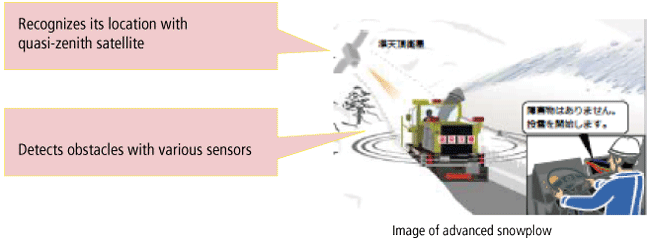
Assistance for auto-driving
Information service that offers information from roads to assist automated driving, including traffic status of the main lane after junction at an interchange.
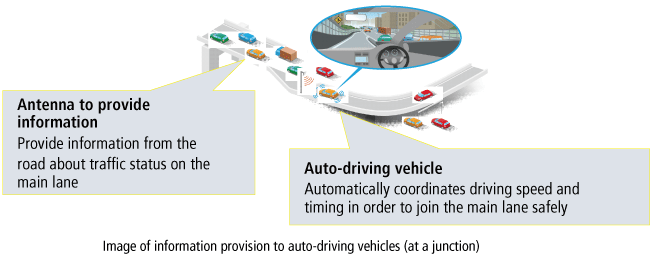
2. Pavement
In 1955, the paved road ratio of national highways in Japan was less than 14%.
The ratio increased sharply thereafter as motorization progressed rapidly, reaching 57% in 1965, 79% in 1975, and over 90% today.
Various paving technologies have been researched and developed since roads in Japan
are subjected to large seasonal temperature differences and heavy rainfall.
Technologies are also being developed to address an aging society and environmental issues.
Drainage and low-noise pavement
The surface is more porous than ordinary pavement, allowing water to seep down through it. The water passes through the pavement and flows along an inclined impermeable course, and is then discharged to side gutters. The pavement drains well, remains non-slippery on the surface even on rainy days, controls spray, and ensures good visibility.
The porousness also suppresses the noise generated by tires and traffic.
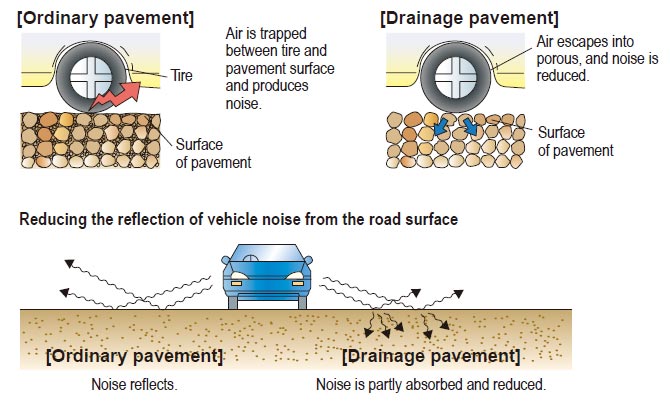
Water-retaining pavement
Water is retained in the pavement and the road temperature is lowered by the heat of water evaporation. Diverse technologies have been proposed, such as injecting water-retaining materials like polymers into the voids of asphalt mixtures, from which rain water and underground water slowly evaporate.
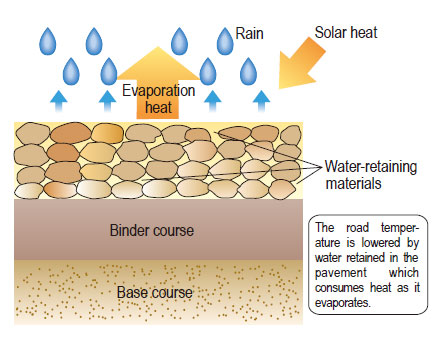
Heat-insulating pavement
Special paint is applied on the pavement surface to reflect infrared rays from the sun and thus reduce the heat which accumulates in the pavement. The paint controls the rise in surface temperature of pavement and improves the thermal environment for pedestrians and road-side areas, helping to mitigate the heat-island phenomenon.
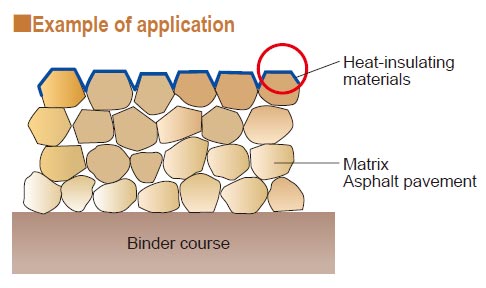
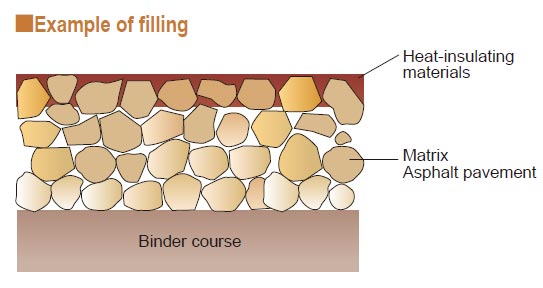
3. Tunnels
The islands of Japan stretch out long and thin from north to south with a backbone of steep mountains rising to elevations of 2,000 to 3,000 m. As about 70% of the land is mountainous, roads must be constructed on the narrow strips of land between steep slopes and the sea, along rivers winding between mountains, and through tunnels.
Tunnels are increasingly used when constructing roads in highly populated areas of cities due to the shortage of land and to protect the environment.
Kan-etsu Tunnel (Kan-etsu Expressway)
The Kan-etsu Tunnel passes through steep mountains with a maximum depth of 1,100 m from a mountain top.
Japan and the fifth-longest in the world. Of its four lanes, the outbound lanes were opened in 1985 and the inbound lanes were completed in 1991.
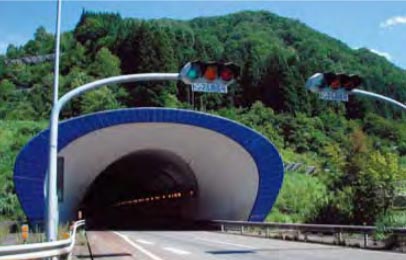
Yamate Tunnel (Central Circular Shinjuku Route of the Metropolitan Expressway)
The Central Circular Shinjuku Route of the Metropolitan Expressway connects Shibuya, Shinjuku and Ikebukuro, which are major sub-centers of Tokyo. Two tunnels account for most of its 11 km length, one for the inbound lanes and the other for the outbound lanes.
The tunnels were completed in 2010.
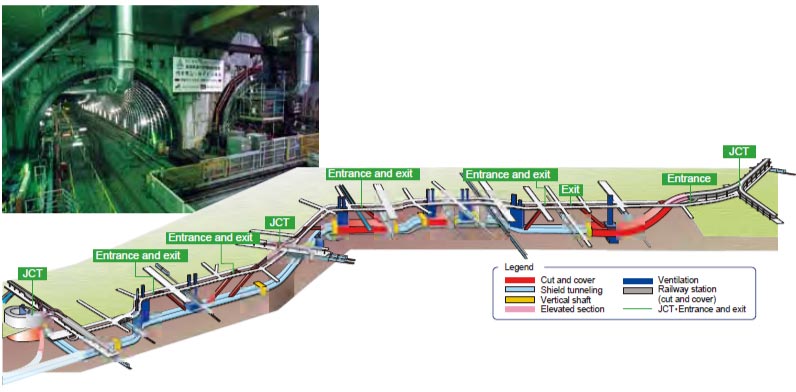
Shield machine
The shield machine cuts the ground with the cutter face in the front, assembles segments inside the machine, and advances through the ground by constructing the tunnel behind. Advanced robotic technologies are used, with a computer controlling the series of tunneling work.
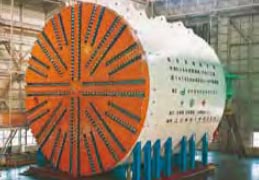
4. Bridges
Japan consists of four major islands of Hokkaido, Honshu, Kyushu and Shikoku and a number of small islands.
Straits and inland seas hinder the traffic between islands.
For well-balanced development of the nation, new transportation axes are needed, and bridges connecting islands have been constructed.
Japan is also highly prone to earthquakes, typhoons and strong winds, so cutting-edge technologies are used for constructing and maintaining longspan bridges that can withstand such severe natural conditions.
Honshu-Shikoku Expressway
The Honshu-Shikoku Expressway, which was completed in 1999 and connects the main island of Honshu with the island of Shikoku, has three routes; the Kobe-Naruto route (the Kobe Naruto Expressway), the Kojima-Sakaide route (the Seto-Chuo Expressway and the JR Seto-Ohashi line), the Onomichi-Imabari route (the Nishi-Seto Expressway).
Control length of these roads is approximately 173 km.
The center span of the Akashi Kaikyo Bridge is 1,991m; the longest in the world, and the height of the main tower is approximately 300m above sea level.

Tokyo Bay Aqua-line Expressway
Of the 15.1 km of the Tokyo Bay Aqua-line Expressway across Tokyo Bay, which was completed in 1997, about 10 km is a tunnel under the ocean and the remaining 5 km is a bridge (Aqua Bridge). A ventilation tower ("Kaze-no-to") was constructed in the middle of the tunnel, and a manmade island ("Umihotaru") was constructed where the tunnel and the bridge meet.
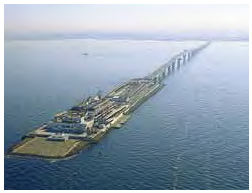
A manmade island "Umihotaru" and the Aqua-line Bridge
